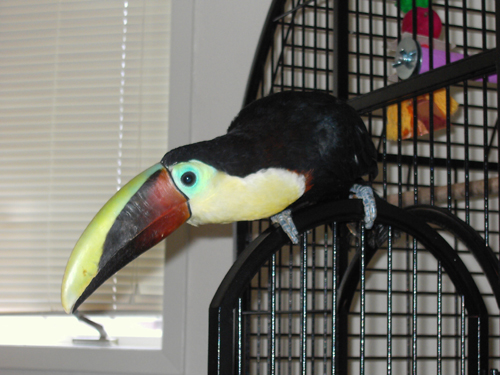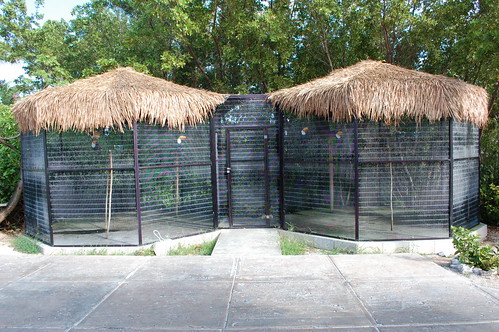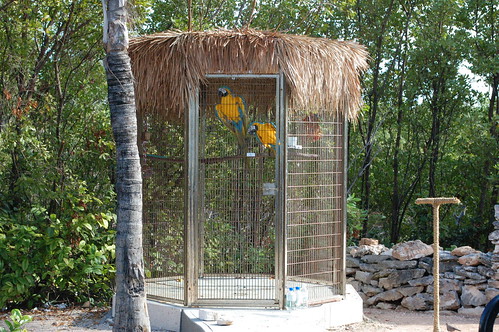
I like to think of my bird’s cage as her bedroom – a happy place, with lots of stuff to do, that belongs to her. I respectfully try keep out, except when it needs cleaning or toy changes. A cage needs to provide safety, security, and comfort for your bird and peace of mind for you in knowing that she will be okay while you are out of the house.
If you are looking for a new cage, or buying your first, here are some rules of thumb to go by:

BIGGER IS BETTER!
Birds are active creatures. Always try to get the largest cage you can that has bar spacing still suitable to your species. A parrot needs to exercise it’s wings and must have enough unobstructed room to do so.
This means that you should look for a cage that is larger your bird’s wing span with several inches on each side to spare. This allows for any toys or perches that are in the cage and could injure the bird during vigorous activity. If you have a long-tailed parrot, remember to plan for room for that too! Your parrot should be able to turn in any direction without bumping any part of its body, wings or tail against anything.
If you have separate sleeper cages for your parrots, a smaller one is okay. I bought Theo, my goffins cockatoo, a travel sized cage (30″X20″X18″) that would never be suitable for daytime use, but is perfect to provide her a good night’s sleep. We haven’t gotten her in it, because she is not yet comfortable with it, but we are working on it.

* Bar spacing is an important consideration.
If the spacing is too wide for the smaller species, a head can get caught in the bars. It’s amazing how a head will fit through the bars in one direction and suddenly become so large that it won’t come out the way it went in.
Also, it makes negotiation around the cage difficult for little feet. Likewise, a larger bird in a cage with too small bar spacing can get a foot caught in the bars.
Appropriate bar spacing:
1/4″ – 1/2″ – finches, canaries
1/2″ – budgies, lovebirds, parrotlets
1/2″ – 5/8″ – cockatiels, ringnecks, doves, pigeons
5/8″ – 3/4″ – conures, poicephalus, caiques, pionus, jardines
3/4″ – 1″ – Amazons, african greys, mini macaws, goffins cockatoos
1″ – 1.5″ – large macaws, large cockatoos
Easy and practical to service.
Does it have slide out trays for easy bottom cleaning? Can you service the food dishes from outside the cage? Is the front door large enough to easily and safely remove your parrot? Is it on wheels?
Most newer cages include optional seed catchers. They are a great help in keeping the mess under control, but they take up 8-12″ more space around the cage on each side. I don’t use mine for that reason.
Safely constructed.
Take a good look around at the cage. Do you see anywhere that a foot could become lodged? Round dome-top cages tend to create this danger. I know this sounds like kicking the tires when you’re buying a car, but does it feel solid when you give it a good shake? Some cheaply made cages have sides that are not welded or bolted together where toes, legs and wings can become lodged.
Some birds are quite capable of breaking welds and larger parrots like macaws and cockatoos need to be in a very well constructed cage. Remember that your bird will explore every inch of this cage when you are away.
If they are anything like mine, they will be devising escape plans, which will be put into action the minute the front door closes. Each of my cages is outfitted with padlocks – 12 in all.
Non-toxic powder-coated or stainless steel.
A stainless steel is going to be the best that you can buy. It will last a lifetime. It won’t chip or rust and will be sturdily made. When you buy a powder-coated cage, please make sure it isn’t from China.
MOST of the cages made there have tested positive for dangerous levels of lead and zinc in their powder coating.
The cage is the biggest investment you will make in your parrot. It will be her home for the entirety of her life, which might be 50 or more years. A stainless steel macaw cage will set you back more than $2,000, but when you divide this among the years of service it will provide, it doesn’t seem like so much.
There are many other cages available, costing less, that are wonderful homes to our companion parrots. Be sure to check them carefully for safety, durability and appropriate sizing. Don’t be afraid to contact the manufacturer for details about the cage and where it was made.
Patty Jourgensen specializes in avian health, behavior and nutrition and has been working with and caring for rescue birds since 1987.



5 comments
I have a Queen of Bavaria conure and I’m looking to buy her a bigger cage. I have gotten a lot of conflicting advice. What bar spacing would you recommend for her?
Do you have any suggestions for cages to travel for your birds. I will be living in and traveling with my birds and dogs for 8 to 12 months. I have portable perch stands up to 4 feet high for outof cage time but unsure how short for actual cage/ I have 1-golden yellow head, 2 – rose breasted cockatoos, and one love bird. My camper has twin beds and I will convert one to hard surface for 3 cages. Love bird no problem. 2 1/2 feet tall would be no problem. Would this we tall enough? Length 2 1/2 to 3 feet long would this work. L am making the cages so would like to as big as possible. They love your cookbook, and pellets, and I will be growing sprouts and micro greens.
I have a comment and a question. I have been using your seasonal feeding system for about one year now and my Yellow Nape Amazon is doing great: plumage is beautiful, her eyes are bright, cere,beak and feet without issue, etc. She is hormonal but not mean. Her problem is…she’s a foodie. 468g. Could you give some guidance as to what volume of the “Bond Building Breakfast” to feed her in the morning. She will absolutely will not eat pellets. I do not feed her seeds, I do give her sprouts, some vegies, some fruit. She is 27 years old and not terribly active, although she has a large cage.
My Sun Conure has a different toy every day that he sheds by his end of the day. Luckily, his cage has a barrier covered bottom to walk on. His toys go through it and Aren’t on the bottom Is that safe for him to not clean it daily?? He does NOT walk in it, but is "scent " a problem that will make him unhealthy? He tears up styrofoam cups that are cut up, magazines that are rolled up, tied and cut the edges, toilet paper and paper towel rolls that have been cut on each end, and styrofoam bottoms that have held meat that are washed very well. Oh, he loves to shred wooded toy bird ladders. These are the "toys " that he loves to play with. He does get a clean new one every day. But I want you make sure that NO possible scent could harm him. He is 26 years old and isn’t as healthy as possible. He has a cage he is happy with, very big and bears are well suited to his size. I don’t know how he could be healthier!..he COULD be friendlier to other people, but he feels he has to "protect " me! But he does get better of the person feeds him! I know he eats well, as I feed him his fruit by hand while he is on my shoulder first thing in the morning He does seem to be a delightful and healthy bird and he IS potty trained!!
Patty has done it again. I’m in the market for a sleeper/travel cage for my girl, and this ought to help.
Leave a comment